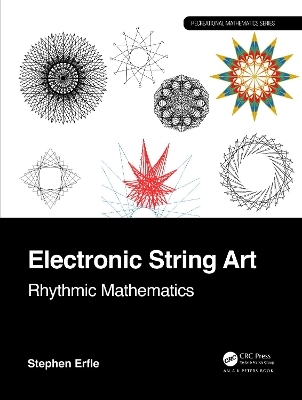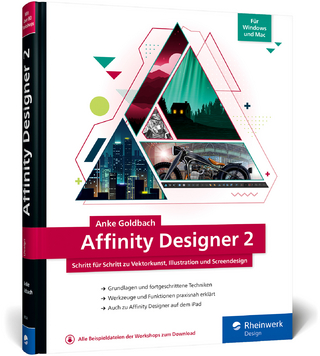
Electronic String Art
Taylor & Francis Ltd (Verlag)
978-1-032-51273-0 (ISBN)
String art is a well-known and popular activity that uses string, a board, and nails to produce artistic images (although there are variations that use different modalities). This activity is beloved because simple counting rules are used to create beautiful images that can both adorn walls and excite young minds. The downside of this highly tactile activity is that it is quite time-consuming and rigid. By contrast, electronic string art offers much more flexibility to set up or change nail locations and counting rules, and the images created from those changes change instantaneously.
Electronic String Art: Rhythmic Mathematics invites readers to use the author’s digital resources available on the ESA website to play with the parameters inherent in string art models while offering concise, accessible explanations of the underlying mathematical principles regarding how the images were created and how they change. Readers will have the opportunity to create visually beautiful works of art while learning concepts from geometry, number theory, and modular arithmetic from approximately 200 short-interdependent sections.
Features
Readers are able to drill-down on images in order to understand why they work using short (1 to 2 page) stand-alone sections
Sections are lessons that were created so that they could be digested in a single sitting
These sections are stand-alone in the sense that they need not be read sequentially but can be referred to based on images that the reader finds interesting
An open-ended, inherently flexible teaching resource for elementary, middle, and high school-level mathematics
The most mathematically challenging sections (or portions of a section) are designated MA and may not be accessible to elementary and middle school readers
Will be appreciated by anyone interested in recreational mathematics or mathematical artworks even if the users are not interested in the underlying mathematics
Includes exercises, solutions, and many online digital resources
These QR codes take you to these digital resources. One takes you directly to the web version of the string art model (used as a starting point for teaching the parameters of the model in Section 25.5). The other takes you to the ESA web page with additional links to a variety of resources.
Stephen Erfle is a professor at Dickinson College. Although he was trained as a microeconomic theorist specializing in industrial organization and regulation, he has spent much of his academic life working at the borders of traditional economics. He has used his economist’s toolkit to examine topics in a wide variety of fields including public health, exercise psychology, political geography, mathematics education, and communications theory in addition to economics. He has consulted for a variety of organizations including the Seagram Classics Wine Company, the Forum on Education Abroad, and the Pennsylvania Department of Health. His Seagram Classics sabbatical reoriented the direction of his teaching and research as it turned his former analytical focus (theorem and proof) into a more empirical focus (what does the data tell us). It also led him to cofound the international business and management major at Dickinson College. One of the core courses in that major, Managerial Decision Making, teaches students to analyze the kinds of decisions he was asked to answer during his time working for Seagram Classics. He has spent much of his time in the past couple of decades devoted to pedagogical issues revolving around providing geometric interpretations and explanations for a variety of topics. The books and papers in these topic areas seek to explain economic and mathematical concepts in intuitive terms, often to students with limited mathematical backgrounds. He received his BS in Mathematics and BA in Economics from University of California, Davis, and Ph.D. in Economics from Harvard University.
Part I. Preliminary Issues. 1. Introduction and Overview. 2. How Polygons are Drawn. 3. String Art Basics. 4. Issues involving Commonality. 5. Cycles. 6. Alternative ways to Obtain an Image. 7. Levels of Subdivision Points. 8. Shape-Shifting Polygons. 9. An Overarching Question. 10. Functionally Modified String Art files. 11. A sampling of Image Archetypes. 12. n = P images. 13. 60-Second Images. 14. Challenge Questions for Part II. 15. Centered-Point Flowers. 16. Double Jump Models. 17. Four Color Clock Arithmetic. 18. Larger Jump Set Models. 19. Busting out of our Polygonal Constraint. 20. Challenge Questions for Part III. 21. Basic Properties of Numbers. 22. Angles in Polygons and Stars. 23. Modular Arithmetic. 24. Modular Multiplicative Inverses, MMI. 25. A Guide to the Web Model. 26. Suggestions for Mathematics Teachers.
| Erscheinungsdatum | 22.02.2024 |
|---|---|
| Reihe/Serie | AK Peters/CRC Recreational Mathematics Series |
| Zusatzinfo | 67 Tables, black and white; 897 Line drawings, color; 91 Line drawings, black and white; 5 Halftones, color; 902 Illustrations, color; 91 Illustrations, black and white |
| Verlagsort | London |
| Sprache | englisch |
| Maße | 210 x 280 mm |
| Gewicht | 1075 g |
| Themenwelt | Kunst / Musik / Theater |
| Mathematik / Informatik ► Informatik ► Grafik / Design | |
| Mathematik / Informatik ► Mathematik ► Allgemeines / Lexika | |
| ISBN-10 | 1-032-51273-3 / 1032512733 |
| ISBN-13 | 978-1-032-51273-0 / 9781032512730 |
| Zustand | Neuware |
| Haben Sie eine Frage zum Produkt? |
aus dem Bereich


